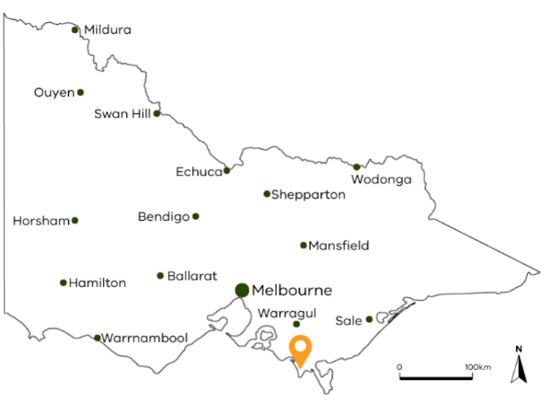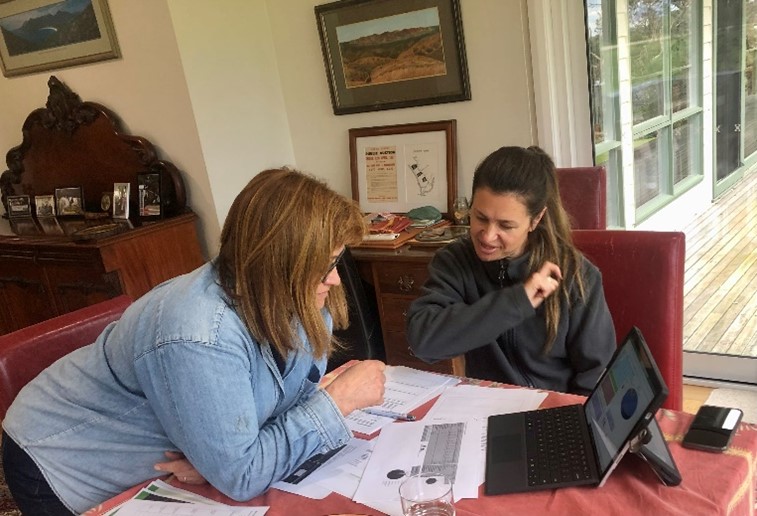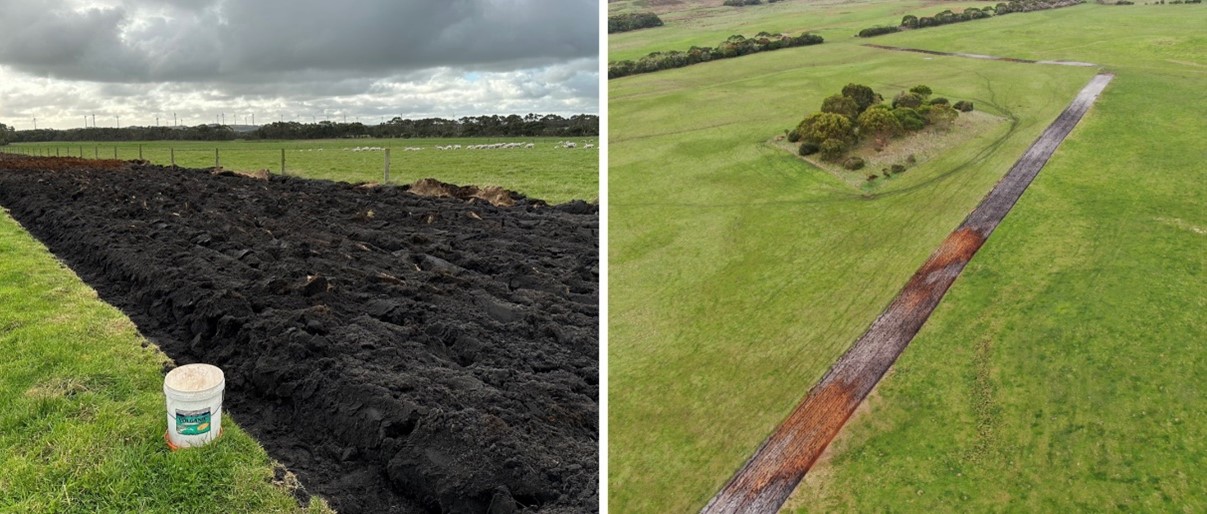Beefing up carbon capture

About Malabar Farm
- Jenny and Paul O’Sullivan and family run 3 farms, which together are a pasture-based beef and sheep farming system in South Gippsland, near Walkerville in south-eastern Victoria.
- Malabar Farm collectively consists of 664 ha, focused on regenerative grazing with a 60:40 ratio of beef to sheep.
- Total production approximates 190,000 and 130,000 kg per year (live weight) of beef and sheep, respectively.
- Across the farm there is approximately 85 ha of woody vegetation covering 13% of the property. This constitutes a mixture of remnant vegetation and trees planted over the last 20 years, which provides habitat to support native birds and animals, shelter for stock and an opportunity to capture carbon.
- The O’Sullivans have a long-standing focus on conservation, biodiversity and best practice within their beef and sheep production system.
Farming and carbon emissions
In Australia, there’s a big focus on how farms manage greenhouse gas (GHG) emissions and store carbon. Efficient production to manage and reduce emissions is becoming increasingly important.
Agriculture Victoria’s On-Farm Emissions Action Plan Pilot is working with Victorian farmers to know, understand, and act on their farm GHG emissions.
The O’Sullivan family believes that good environmental stewardship of the land is essential for ongoing production sustainability. They joined the Agriculture Victoria Pilot program to get practical advice on how to reduce emissions on their farm.
‘Everyone says agriculture is the answer, but how do we reduce emissions and sequester more and also continue to be profitable’, said Jenny.
Through the Pilot program, they were able to objectively benchmark their farm’s emissions, learn about carbon sequestration opportunities, and work towards lowering their overall emissions.
Malabar Farm, located about 5 km north-west of Walkerville in South Gippsland, features rolling hills and a mild maritime climate. The soil is mainly sandy loam and yellow acid duplex, with an average annual rainfall of 950 mm.
The farm has been in the family since the 1960s. Jenny and Paul took over in 1991, aiming to produce high-quality beef and lamb sustainably. They have planted trees to create habitats and improve the soil, including revitalization of fragile sand hills, on the property.
Jenny said, ‘It’s about land use change for the better, whether that’s getting legumes into the pasture, or improving the soil and perennial species. The biodiversity corridors also offer the stock protection from the elements’.
They use solar power (7 kWh/day) for their workshop, fences and pumps. Regular soil testing helps them manage nutrients and improve production efficiency. They also monitor soil organic carbon, which is stable at 1.7% to 2.9% in the top 30 cm of sandy soils.

The O’Sullivans open their farm to the public and school groups to educate people about sustainable farming in the red meat industry. Jenny mentioned there’s a lot of media focus on the emissions from red meat production, comparing it to coal.
‘Currently there is a lot of focus in the media about the emission impact of red meat production, like red meat is the new coal’, said Jenny.
Their goal is to be environmentally sustainable and educate others about their practices, using new technologies to reduce the carbon footprint of red meat production.
Know Your Number
‘Know Your Number’ is a way to measure the greenhouse gas (GHG) emissions from a farm using a special tool like the Greenhouse Accounting Framework (GAF) calculator.
This number is the total amount of carbon dioxide equivalents (CO2-e) produced by the farm each year. It includes three types of emissions, called scopes:
- Scope 1: Emissions from livestock (like enteric methane from sheep and cows), nitrous oxide from nitrogen fertilizer application, urine and dung and carbon dioxide from fossil fuel use.
- Scope 2: Emissions resulting from the electricity the farm uses.
- Scope 3: Emissions created in manufacturing products the farm buys (embedded).
Farms can also capture and store carbon in trees and soils, a process known as carbon sequestration. This captured carbon can be used to balance against their emissions, which is called ‘insetting’.

For the O’Sullivans’ farm, the emissions analysis for 2021–22 estimated that enteric methane from livestock accounted for 87% of the net on-farm emissions, where beef and sheep made up 53% and 34% of this total, respectively. Nitrous oxide emissions from urine, dung and leaching accounted for around 12% of emissions.
Forty hectares of trees provided a 14% inset advantage to the total farm emissions, where the current tree belts were estimated to capture 378 tonnes CO2-e per year. The rate of annual carbon sequestration in 2021 was estimated at between 1.9 and 8.0 tCO2-e per hectare, where the higher rates were associated with the 6-year-old trees and the lower rates with the remnant (50-year-old) vegetation.
Emissions intensity is a measure of the emissions per unit of product. For the O’Sullivans, the emission intensity of their red meat production was below industry average, where per kilogram of liveweight (LWT) net emissions were 10 kg CO2-e for the beef enterprise when tree sequestration was excluded.
This compares with an average industry range of 11 to 18 kg CO2-e per kg LWT1. For the lamb production, this was 6 kg CO2-e per kg LWT excluding sequestration, with the industry average being between 6 and 10 kg CO2-e per kg LWT1.
When including the carbon stored by trees into the calculation, the emissions intensities drop to 9 kg CO2-e for the beef and 5 kg CO2-e for sheep, per kg LWT.
Acting to reduce emissions
For the O’Sullivans’ enterprise, additional new plantings as either environmental or agroforestry will provide further carbon inset potential. A Pilot Action Plan Grant is supporting the establishment of a 1.7 ha shelter belt of native trees, as a 1.7 km long and 10-metre-wide plantation, which will provide ongoing carbon capture, biodiversity and livestock shelter benefits.
On the autumn break, in late April/early May 2022, the plantation footprint was sprayed with knock-down ahead of mouldboard ploughing and tree seeds were hand-spread in 3 rows for the length of the plantation. With the area being fenced off, the clock is set on providing a further 25 years of carbon capture for the O’Sullivans’ farm.

The Pilot Grant will also support building on benchmark (2019) soil sampling with follow-up (2023 and 2026) sampling to monitor change in soil organic carbon levels across several paddocks and organic amendment test treatments. Treatments will include a blend of animal manures and chicken bedding litter. The O’Sullivans consider the on-farm demonstration trial as a valuable tool for assessing carbon sequestration potential of their soil.

For the stock, ongoing production and reproductive efficiency and reduced time to turn-off can be improved through continuing a focus on improved genetic selection (for example, screening of bulls for feed conversion efficiency).
The future
In the medium term, the goal is to make the farm ready for feed additives by making infrastructure changes. This will help them quickly adopt feed additives once they are proven to work and are affordable.
We are interested in the opportunities for using feed additives, where formulations currently under industry development are likely to reduce the enteric methane emissions from stock
For the red meat industry, there are many current and new ways to reduce its carbon footprint. The O’Sullivans aim to be an example of an environmentally responsible red meat farm for the 21st century.
Finally, regarding the Pilot program and the future, Jenny said, ‘The first step for farmers is to understand the carbon emissions from their enterprise. They can then explore ways to reduce emissions and inset emissions on farm through trees and the soil. The Pilot program was a great opportunity to really understand our current situation and to explore best options to reduce our carbon footprint.’

This case study is part of a series outlining practical actions Victorian farmers are implementing on farm as part of the Agriculture Victoria, On-Farm Emissions Action Plan Pilot program .
Acknowledgements
Author – James Nuttall, Agriculture Victoria, 2024
For further information on the project email actionplanpilot@agriculture.vic.gov.au
The On-Farm Emissions Action Plan Pilot is part of the Victorian Government’s Agriculture Sector Emissions Reduction Pledge to provide practical information, tools and services to support farmers to understand and reduce emissions. The Pilot will work with up to 250 farm businesses across the state to estimate their on-farm emissions profile and identify potential actions to manage and reduce emissions while maintaining productivity and profitability.
References
1. Meat and Livestock Australia (2021). V.SCS.0016, Carbon accounting technical manual.